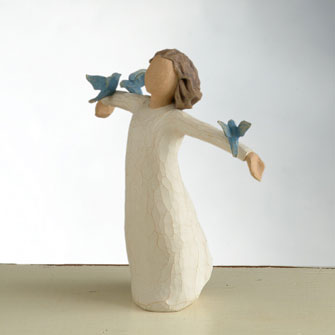
figurine happiness created by Susan Lordi willowtree
 figurine happiness created by Susan Lordi willowtree |
What is happiness? |
| Is
it possible to lead a happy life? Or do we all have our ups and downs
oscillating around some mean neutral state? More and more I come to the
conclusion that surprisingly simple strategies may increase the
frequency of happy life events while reducing that of sad and
boring ones. As neurobiologist I might come to such an optimistic
conclusion, dampened however by recently accumulating changes in our
social environment. |
| With most of the more evolved vertebrates, we share a common mental pathway that uses pleasure (or its counterpart displeasure) as a means to optimize behavior (Cabanac et al 2009). Already early in life we start to accumulate a rich store of experiences concerning possible consequences of events and actions, of actions attributed to others and to ourselves, on a short and on a longer time scale. |
| Such consequences are not always easy to predict. The relationships can be rather complex, and it may take years or even decades to adopt behaviors that, with higher-than-chance probability, will result in satisfying and pleasurable experiences, without neutralizing displeasure following on its feet. E.g., it may be an extremely pleasurable experience to jump from the roof of a tall building, but it will be more than neutralized by the ensuing harm. |
| The next weekend is impending, and I have no appointments so far. What will I do? The weather is fine, so I should be ready for a little trip to the countryside, be it on foot, be it on my bicycle. But what exactly will be my choice? My thoughts ramble back through hundreds of similar occasions, comparing, weighing, summarizing quickly thousands of impressions. Of course my tendency will be to repeat those trips with the most agreeable outcome, and to avoid those evoking bad memories. |
| This is just one example for several occasions forcing us to come to a decision. And we always decide on the basis of prior experience. In retrospect, some of such decisions turn out as wrong and we end up with disappointment. Very likely in the future we will not come to the same decision any more. But by and by, we increase our collection of decisions with agreeable consequences. E.g., we get used to meet people that fit our personal communication style more often than others; we call them friends. |
| Happiness is not just an activated Nucleus accumbens. To most of us it is obvious that real happiness is not a transient, short lasting condition, but a desirable long-term state. Most habits, once we have acquired them, will not require any conscious decisions any more. Sub-cortical parts of our brain take over and relieve us from the pressing need to decide in every minute what to do next. We may quite easily lead a happy live, once we managed to delegate to these sub-cortical circuits decisions that repeatedly have proven as favorable. Then we may follow for the rest of our life happy habits. |
| Well - do we? Experiences of every day life teach us that even the best habit cannot be pursued forever. Our favorite cinema is replaced by a supermarket. The owner of our preferred restaurant changes, and so does its atmosphere. Our best friend has died, and we cannot meet him / her any more. Things are changing, and they are changing faster and faster in each new century. Maybe it has become easier today to become happy, but surely not easier to stay so. |
| 12/08 < MB
(4/09) > 5/09 |
| Cabanac M, Cabanac AJ, Parent A (2009) The emergence of consciousness in phylogeny. Behav Brain Res 198:267-72 |